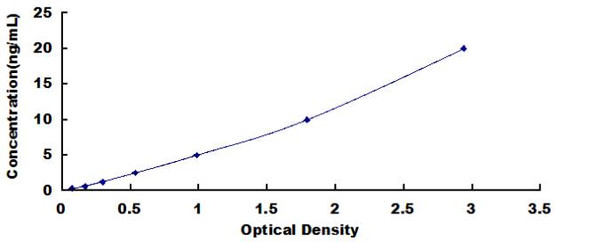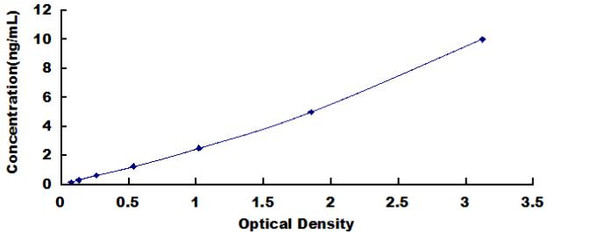Human ADAMTS9(A Disintegrin And Metalloproteinase With Thrombospondin 9)ELISA Kit (HUES03464)
- SKU:
- HUES03464
- Product Type:
- ELISA Kit
- Size:
- 96 Assays
- Uniprot:
- Q9P2N4
- Sensitivity:
- 0.19ng/mL
- Range:
- 0.31-20ng/mL
- ELISA Type:
- Sandwich
- Reactivity:
- Human
- Sample Type:
- Serum, plasma and other biological fluids
- Research Area:
- Cell Biology
Description
Human ADAMTS9 (A Disintegrin And Metalloproteinase With Thrombospondin 9) ELISA Kit
The Human ADAMTS9 (A Disintegrin and Metalloproteinase with Thrombospondin 9) ELISA Kit is a powerful tool for the accurate assessment of ADAMTS9 levels in human samples including serum, plasma, and cell culture supernatants. This kit offers exceptional sensitivity and specificity, ensuring consistent and precise results for a variety of research purposes.ADAMTS9 is a key enzyme involved in regulating extracellular matrix remodeling and tissue development. Dysregulation of ADAMTS9 has been linked to various diseases including cancer, arthritis, and cardiovascular disorders, making it a valuable biomarker for understanding disease pathophysiology and potential therapeutic interventions.
With the Human ADAMTS9 ELISA Kit, researchers can confidently study the role of ADAMTS9 in health and disease, paving the way for advancements in personalized medicine and targeted therapies. Trust in the reliability and accuracy of this ELISA kit for your research needs.
| Assay type: | Sandwich |
| Format: | 96T |
| Assay time: | 4.5h |
| Reactivity: | Human |
| Detection Method: | Colormetric |
| Detection Range: | 0.31-20 ng/mL |
| Sensitivity: | 0.19 ng/mL |
| Sample Volume Required Per Well: | 100µL |
| Sample Type: | Serum, plasma and other biological fluids |
| Specificity: | This kit recognizes Human ADAMTS9 in samples. No significant cross-reactivity or interference between Human ADAMTS9 and analogues was observed. |
This ELISA kit uses Sandwich-ELISA as the method. The micro ELISA plate provided in this kit has been pre-coated with an antibody specific to Human ADAMTS9. Standards or samples are added to the appropriate micro ELISA plate wells and combined with the specific antibody. Then a biotinylated detection antibody specific for Human ADAMTS9 and Avidin-Horseradish Peroxidase (HRP) conjugate are added to each micro plate well successively and incubated. Free components are washed away. The substrate solution is added to each well. Only those wells that contain Human ADAMTS9, biotinylated detection antibody and Avidin-HRP conjugate will appear blue in color. The enzyme-substrate reaction is terminated by adding Stop Solution and the color turns yellow. The optical density (OD) is measured spectrophotometrically at a wavelength of 450 nm ± 2 nm. The OD value is proportional to the concentration of Human ADAMTS9. The concentration of Human ADAMTS9 in samples can be calculated by comparing the OD of the samples to the standard curve.
| UniProt Protein Function: | Cleaves the large aggregating proteoglycans, aggrecan (at the '1838-Glu-|-Ala-1839' site) and versican (at the '1428-Glu-|-Ala-1429' site). Has a protease-independent function in promoting the transport from the endoplasmic reticulum to the Golgi apparatus of a variety of secretory cargos. |
| NCBI Summary: | This gene encodes a member of the ADAMTS (a disintegrin and metalloproteinase with thrombospondin motifs) protein family. Members of the family share several distinct protein modules, including a propeptide region, a metalloproteinase domain, a disintegrin-like domain, and a thrombospondin type 1 (TS) motif. Individual members of this family differ in the number of C-terminal TS motifs, and some have unique C-terminal domains. Members of the ADAMTS family have been implicated in the cleavage of proteoglycans, the control of organ shape during development, and the inhibition of angiogenesis. This gene is localized to chromosome 3p14. 3-p14. 2, an area known to be lost in hereditary renal tumors. Alternative splicing results in multiple transcript variants encoding different isoforms that may undergo similar proteolytic processing. [provided by RefSeq, Jan 2016] |
| UniProt Code: | Q9P2N4 |
| NCBI GenInfo Identifier: | 974005284 |
| NCBI Gene ID: | 56999 |
| NCBI Accession: | NP_001305710. 1 |
| UniProt Secondary Accession: | Q9P2N4,Q9NR29, A1L4L0, B7ZVX9, B9ZVN0, |
| UniProt Related Accession: | Q9P2N4 |
| Molecular Weight: | 212 |
| NCBI Full Name: | A disintegrin and metalloproteinase with thrombospondin motifs 9 isoform 4 |
| NCBI Synonym Full Names: | ADAM metallopeptidase with thrombospondin type 1 motif 9 |
| NCBI Official Symbol: | ADAMTS9 |
| NCBI Protein Information: | A disintegrin and metalloproteinase with thrombospondin motifs 9 |
| UniProt Protein Name: | A disintegrin and metalloproteinase with thrombospondin motifs 9 |
| UniProt Gene Name: | ADAMTS9 |
As the OD values of the standard curve may vary according to the conditions of the actual assay performance (e. g. operator, pipetting technique, washing technique or temperature effects), the operator should establish a standard curve for each test. Typical standard curve and data is provided below for reference only.
| Concentration (ng/mL) | O.D | Average | Corrected |
| 20 | 2.349 2.393 | 2.371 | 2.313 |
| 10 | 1.659 1.671 | 1.665 | 1.607 |
| 5 | 0.965 0.939 | 0.952 | 0.894 |
| 2.5 | 0.417 0.437 | 0.427 | 0.369 |
| 1.25 | 0.231 0.229 | 0.23 | 0.172 |
| 0.63 | 0.163 0.153 | 0.158 | 0.1 |
| 0.31 | 0.107 0.111 | 0.109 | 0.051 |
| 0 | 0.052 0.064 | 0.058 | -- |
Precision
Intra-assay Precision (Precision within an assay): 3 samples with low, mid range and high level Human ADAMTS9 were tested 20 times on one plate, respectively.
Inter-assay Precision (Precision between assays): 3 samples with low, mid range and high level Human ADAMTS9 were tested on 3 different plates, 20 replicates in each plate.
| Intra-assay Precision | Inter-assay Precision | |||||
| Sample | 1 | 2 | 3 | 1 | 2 | 3 |
| n | 20 | 20 | 20 | 20 | 20 | 20 |
| Mean (ng/mL) | 0.97 | 1.76 | 8.08 | 0.94 | 1.81 | 8.61 |
| Standard deviation | 0.06 | 0.09 | 0.37 | 0.06 | 0.09 | 0.39 |
| C V (%) | 6.19 | 5.11 | 4.58 | 6.38 | 4.97 | 4.53 |
Recovery
The recovery of Human ADAMTS9 spiked at three different levels in samples throughout the range of the assay was evaluated in various matrices.
| Sample Type | Range (%) | Average Recovery (%) |
| Serum (n=5) | 92-107 | 98 |
| EDTA plasma (n=5) | 85-99 | 91 |
| Cell culture media (n=5) | 88-101 | 95 |
Linearity
Samples were spiked with high concentrations of Human ADAMTS9 and diluted with Reference Standard & Sample Diluent to produce samples with values within the range of the assay.
| Serum (n=5) | EDTA plasma (n=5) | Cell culture media (n=5) | ||
| 1:2 | Range (%) | 95-109 | 90-102 | 95-108 |
| Average (%) | 100 | 96 | 101 | |
| 1:4 | Range (%) | 94-104 | 86-96 | 87-102 |
| Average (%) | 99 | 91 | 93 | |
| 1:8 | Range (%) | 89-104 | 84-95 | 88-102 |
| Average (%) | 95 | 90 | 93 | |
| 1:16 | Range (%) | 91-103 | 81-90 | 83-94 |
| Average (%) | 98 | 86 | 89 |
An unopened kit can be stored at 4°C for 1 month. If the kit is not used within 1 month, store the items separately according to the following conditions once the kit is received.
| Item | Specifications | Storage |
| Micro ELISA Plate(Dismountable) | 8 wells ×12 strips | -20°C, 6 months |
| Reference Standard | 2 vials | |
| Concentrated Biotinylated Detection Ab (100×) | 1 vial, 120 µL | |
| Concentrated HRP Conjugate (100×) | 1 vial, 120 µL | -20°C(shading light), 6 months |
| Reference Standard & Sample Diluent | 1 vial, 20 mL | 4°C, 6 months |
| Biotinylated Detection Ab Diluent | 1 vial, 14 mL | |
| HRP Conjugate Diluent | 1 vial, 14 mL | |
| Concentrated Wash Buffer (25×) | 1 vial, 30 mL | |
| Substrate Reagent | 1 vial, 10 mL | 4°C(shading light) |
| Stop Solution | 1 vial, 10 mL | 4°C |
| Plate Sealer | 5 pieces | |
| Product Description | 1 copy | |
| Certificate of Analysis | 1 copy |
- Set standard, test sample and control (zero) wells on the pre-coated plate and record theirpositions. It is recommended to measure each standard and sample in duplicate. Note: addall solutions to the bottom of the plate wells while avoiding contact with the well walls. Ensuresolutions do not foam when adding to the wells.
- Aliquot 100µl of standard solutions into the standard wells.
- Add 100µl of Sample / Standard dilution buffer into the control (zero) well.
- Add 100µl of properly diluted sample (serum, plasma, tissue homogenates and otherbiological fluids) into test sample wells.
- Cover the plate with the sealer provided in the kit and incubate for 90 min at 37°C.
- Aspirate the liquid from each well, do not wash. Immediately add 100µL of BiotinylatedDetection Ab working solution to each well. Cover the plate with a plate seal and gently mix. Incubate for 1 hour at 37°C.
- Aspirate or decant the solution from the plate and add 350µL of wash buffer to each welland incubate for 1-2 minutes at room temperature. Aspirate the solution from each well andclap the plate on absorbent filter paper to dry. Repeat this process 3 times. Note: a microplatewasher can be used in this step and other wash steps.
- Add 100µL of HRP Conjugate working solution to each well. Cover with a plate seal andincubate for 30 min at 37°C.
- Aspirate or decant the solution from each well. Repeat the wash process for five times asconducted in step 7.
- Add 90µL of Substrate Reagent to each well. Cover with a new plate seal and incubate forapproximately 15 min at 37°C. Protect the plate from light. Note: the reaction time can beshortened or extended according to the actual color change, but not by more than 30min.
- Add 50 µL of Stop Solution to each well. Note: Adding the stop solution should be done inthe same order as the substrate solution.
- Determine the optical density (OD value) of each well immediately with a microplate readerset at 450 nm.









